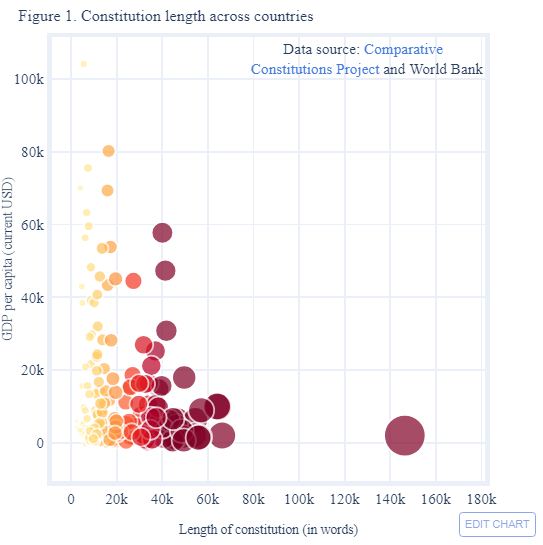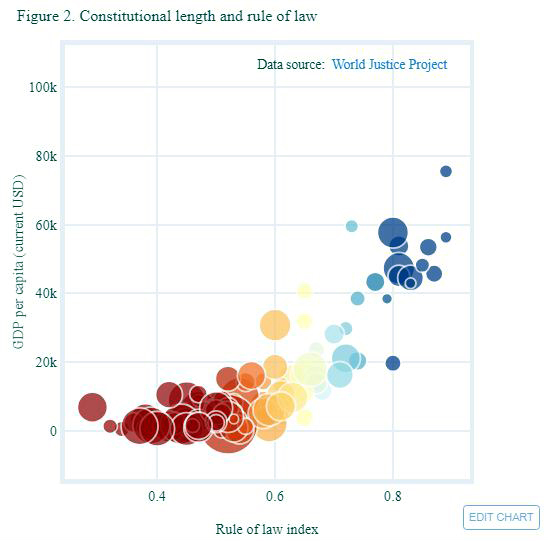The Indian Constitution is the world’s most obscure and verbose. It is complex and 146,000 words long. Instead of helping this only hurts the country’s democracy and administration. (see story below).
The U.S. Constitution contains only 4,543 words. It can be read and understood by common citizens. It has been amended only 27 times in its 230-year history. And it has helped create a superpower. Why not learn from it?
-Bhanu Dhamija
Follow @BhanuDhamija
[Excerpts of article first published on Pragati.com]
By Surbhi Bhatia, Saurabh Modi]
India’s constitution is way too long compared to the rest of the world. This imposes costs on us.
The constituent assembly got on with the task of drafting the Indian constitution on December 9, 1946 to meet the ambitions of millions of Indians. The assembly convened for close to three years to draw the document that would parent the newly born nation granting it political security and a future filled with prosperity. The code so drafted was more than 1,46,000 words, making it the bulkiest constitution ever drafted.
Members of the assembly argued that this was a feature and not a bug. At a later stage in the assembly, the criticism of its verbosity was deflected by the justification, a complex society requires complex rules. One member, Lakshmikant Maitra said:
[A] criticism about this Constitution is that it is a huge document. Enormous amount of extraneous matter, unnecessary matter has been pressed into it. Perhaps there is some truth in it also; but is it realized that you have drawn up a Constitution for 340 millions of people? Look at the magnitude or the size of your State and its people. Has it any parallel in the world? Has any other country, and other State in the world got such a municipality of problems, of such complexity and diversity as we have got. Therefore in the nature of things, this was inevitable and I make no apology for it.
The thought behind designing the constitution was that rules required to govern complex and diverse societies should also be complex. This is a fallacy.
Constitutional rules dictate the manner in which individuals interact in any society. These rules should be simple, not complex.
Individuals and small groups within a society interact with each other using privately formed rules of association. The constitution needs to do no more than provide a framework within this process can work smoothly. It’s role is to protect the rights of its citizens and enable voluntary exchanges. It should contain broad rules to this effect, instead of going into detail to cover every possible eventuality.
India’s constitution contains 395 articles and 12 schedules. There are two bad consequences of such length.
One, it stops diversity and harmony from flourishing. In a democracy, the majority makes the rules. This can be detrimental to the interests of the under-represented. For example, consider the debate around the official language. This was the most divisive issue in the constituent assembly. Every group asserted its interest in making its spoken language the official one. Privileging one language over others was a bad idea that generated tensions that linger to this day.
Two, complex rules impose high transaction costs. The private cost imposed on individuals is that of compliance with the rules. Because laws are so complex, it gets difficult to know what the law is, how it applies to us, and how we must demonstrate compliance to the regulators. Bureaucrats enjoy discretion and the ability to manipulate use these rules to extract rents.
The public cost of complex rules is the heavy burden of the administration cost required to enforce them. Bureaucracies enforcing complex rules increase their size and scope of inspection and supervision.
Across 203 countries, the average length of constitutions is 14,350 words. The Indian constitution is 10 times this length.
It far outdoes the next in order: Nigeria (66,263 words), Malaysia (64,080 words) and Brazil (66,263 words) by being more than double their sizes. Figure 1 highlights the stark contrast between the size of constitutions of the wealthiest nations with that of nations with a low per capita income. The most prosperous countries have limited rules. The number of words is a clean proxy to assessment of length of a document. As the lengths of the constitutions increase, the GDP per capita of nations settles in the lower half, at the extreme end of which stands India, an outlier.

For any nation, wealth creation is a direct function of the economic freedom its citizens have. This freedom remains constrained or unconstrained depending on its design granted by the nation’s constitution. A verbose and complex document that yields itself to discretion always limits the agency of individuals. On the flip side, a succinct document, by virtue of having clear guidelines, leads to limited rules, thereby creating an unconstrained environment.
This divergence in design is visible when the constitutions of India and US are compared. The Indian constitution grants powers to the state to intervene while the American constitution limits it.
There is a strong positive correlation between the prosperity of a nation and its rule of law. Figure 2 maps the complexity of rules with GDP per capita as well as rule of law. On the extreme left of the primary axis, Venezuela has a low GDP, low rule of law score, and a verbose constitution comprising of 37,344 words.
India stands midway, a little ahead of Mexico. The Scandinavian countries, along with the US, Japan, and South Korea form the region of high GDP-high rule of law with the smallest of all constitutions in the world.

Among the few members of the assembly who wanted a simple constitution was Shrimati Renuka Ray, who stated:
I was one of those who had believed that it would have been better not to have entered into such a welter of details, but to have drawn up a constitution on more general lines. Sir, a written constitution, however, elastic, must, to a very large extent, be a rigid constitution. It would have been better, I think, to have eliminated as far as possible rigidity, by not going into too many details.
But the argument that held with this house was that we were concerned with numerous complex problems, that living conditions in this country differed so much and so widely that much detail was necessary.
But for the life of me, I cannot understand why we had to go to such details as to put in the salaries of high dignitaries of the State, like the President and the salaries of Judges, in the Constitution.
Why should the Constitution thus usurp what are really the normal duties of Parliament? So in the Constitution what purpose can be served by prescribing the exact amount of the salaries?
While the members of the constituent assembly did manage to accomplish the enormous task of drafting the founding document to a nation filled with aspirations, the particular enormity of this document may not be a cause for celebration.
This article was first published on Pragati on 12 March 2019.
